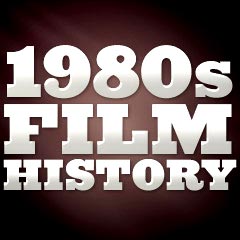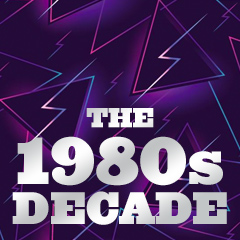|
Other Films with Military Themes:
- Taylor Hackford's pro-militaristic, adult-style melodramatic
romance An Officer and a Gentleman (1982) featured an award-winning
song "Up Where We Belong" and starred Debra Winger and Richard Gere
in the lead roles as paper-mill worker and aspiring Navy jet pilot respectively
- the serious, surprise hit Taps (1981) included
early performances of Tom Cruise, Timothy Hutton and Sean Penn as American
military academy cadets participating in a revolt
-
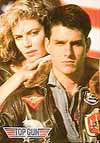 Tony
Scott's ultra-positive, macho Top Gun (1986) with ear-shattering,
competitive acrobatic flying sequences, a homosexual sub-text, a rock soundtrack (from Simpson/Bruckheimer)
and award-winning hit song by Berlin "Take My Breath Away," and mega-star
Tom Cruise as Lt. Pete "Maverick" Mitchell - a crack, fighter pilot
trainee at the US Navy's Fighter Weapons School at San Diego; noted
for the line: "I feel the need - the need for speed" Tony
Scott's ultra-positive, macho Top Gun (1986) with ear-shattering,
competitive acrobatic flying sequences, a homosexual sub-text, a rock soundtrack (from Simpson/Bruckheimer)
and award-winning hit song by Berlin "Take My Breath Away," and mega-star
Tom Cruise as Lt. Pete "Maverick" Mitchell - a crack, fighter pilot
trainee at the US Navy's Fighter Weapons School at San Diego; noted
for the line: "I feel the need - the need for speed"
- sci-fi combat allegorizing the Vietnam war experience
in John McTiernan's Predator (1987) with Arnold Schwarzenegger
leading a commando unit to kill a chameleon-like, camouflaged alien
creature in the jungles of Central America
- director John Badham's comedy/drama WarGames (1983)
starred a young Matthew Broderick as high-school computer whiz David
Lightman who accidentally broke into an air-defense, missile-base supercomputer at NORAD and nearly started World War III with a Defense Department game called
"Global Thermonuclear Warfare"
- high-energy, improvisational comic Robin Williams starred
in Barry Levinson's fact-based, main-stream success Good Morning,
Vietnam (1987) as iconoclastic, anti-establishment, unconventional
60s disc jockey Adrian Cronauer from Saigon's Armed Forces Radio
Dance-Musical Films:
Although the much-publicized Annie (1982) by renowned director
John Huston failed, other non-traditional dance musicals flourished:
- Staying Alive (1983), written and directed
by Sylvester Stallone, starred John Travolta (in his 10th film)
as an aspiring Broadway dancer (six years after Saturday
Night Fever (1977)); although successful at the box-office,
it contributed to the downfall of Travolta's career for most of the
rest of the decade
-
 Adrian
Lyne's slick Flashdance (1983) was the immensely popular, highly
kinetic, music-video style film - with an Oscar-winning title song by
Irene Cara. It featured 19 year-old Jennifer Beals in her first starring
role as Alex - a day welder in Pittsburgh and night dancer in a men's
club who aspired to successfully audition for ballet school. [The film
almost singlehandedly inspired off-the-shoulder, oversized torn sweatshirts,
legwarmers, the aerobics exercise class craze of the 80s, and the skillful
art of removing one's bra from under one's shirt; it also introduced
two newcomers, writer Joe Eszterhas and producer Jerry Bruckheimer (who
went on to produce Beverly Hills Cop (1984) and Top Gun (1986),
among other films)] Adrian
Lyne's slick Flashdance (1983) was the immensely popular, highly
kinetic, music-video style film - with an Oscar-winning title song by
Irene Cara. It featured 19 year-old Jennifer Beals in her first starring
role as Alex - a day welder in Pittsburgh and night dancer in a men's
club who aspired to successfully audition for ballet school. [The film
almost singlehandedly inspired off-the-shoulder, oversized torn sweatshirts,
legwarmers, the aerobics exercise class craze of the 80s, and the skillful
art of removing one's bra from under one's shirt; it also introduced
two newcomers, writer Joe Eszterhas and producer Jerry Bruckheimer (who
went on to produce Beverly Hills Cop (1984) and Top Gun (1986),
among other films)]
- Footloose (1984) with
John Lithgow as a strict minister and Kevin Bacon as the illegal dancer
in town featured Kenny Loggins' hit single of the title song
- Singer Prince (his first starring film) played "The
Kid" in the feature-length music video Purple Rain (1984),
and succeeded in having the #1 movie, album, and single simultaneously
- the teen-oriented dance/romance Dirty Dancing (1987)
about a young girl named Baby (Jennifer Grey, Joel's daughter) finding
sexual awakening with Patrick Swayze in the early 60s through wild dancing
at a Catskills vacation resort
- Western-style Saturday Night Fever film, James
Bridges' Urban Cowboy (1980) featured Houston honky-tonks, mechanical
bull-riding in bars, blue-collar cowboys, and country music dancing
(including the Cotton-Eyed Joe) - and popular young stars John Travolta
and Debra Winger
The Rise of Independent and Non-Hollywood Films:
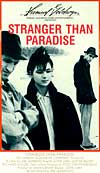 Independent
(or "indies") films made by various directors and writers provided
uncompromising, low-budget, original visions of reality outside the studio
system, following in the tradition of the first wave of independents by
John Cassavetes in the 60s. Innovative films included Jim Jarmusch's acclaimed
minimalist road-film comedy Stranger Than Paradise (1984) (that
won the Camera d'Or at Cannes in 1984) and another odyssey film of three
escaped prisoners entitled Down By Law (1986). Camp director John
Waters' Polyester (1981) included smelly Odorama; he also directed
Hairspray (1988). Independent
(or "indies") films made by various directors and writers provided
uncompromising, low-budget, original visions of reality outside the studio
system, following in the tradition of the first wave of independents by
John Cassavetes in the 60s. Innovative films included Jim Jarmusch's acclaimed
minimalist road-film comedy Stranger Than Paradise (1984) (that
won the Camera d'Or at Cannes in 1984) and another odyssey film of three
escaped prisoners entitled Down By Law (1986). Camp director John
Waters' Polyester (1981) included smelly Odorama; he also directed
Hairspray (1988).
 Writer/director
David Lynch made some of his best films in the 80s. His brilliant but
disturbing Blue Velvet (1986) starred Dennis
Hopper who revitalized his acting career in the repulsive role as the
villainous, sadistic, and blackmailing Frank Booth toward a brutalized
Isabella Rossellini. The unique film visualized the repulsive and twisted
horrors that lurked behind ordinary small-town life - all stemming from
the mysterious discovery of a severed human ear in a field by a naive
college student. Writer/director
David Lynch made some of his best films in the 80s. His brilliant but
disturbing Blue Velvet (1986) starred Dennis
Hopper who revitalized his acting career in the repulsive role as the
villainous, sadistic, and blackmailing Frank Booth toward a brutalized
Isabella Rossellini. The unique film visualized the repulsive and twisted
horrors that lurked behind ordinary small-town life - all stemming from
the mysterious discovery of a severed human ear in a field by a naive
college student.
Director Stuart Gordon's outrageous H.P. Lovecraft adaptation Re-Animator
(1985) contained gore and demented black humor. German film-maker
Wim Wenders directed the haunting Paris, Texas (1984) with Nastassja
Kinski (as a lost wife working in a peep-show behind a one-way window)
and Harry Dean Stanton as wandering husband Travis (on an obsessive quest to piece together his family)
in an impressive Sam Shepard adaptation. The non-linear film included a Ry Cooder soundtrack, and an impressive opening credits sequence in the desert.
Maverick filmmaker Jonathan Demme (noted for The
Silence of the Lambs (1991) and Philadelphia (1993) in
the next decade) began his career as a B-movie director/writer and trainee
under Roger Corman, and had a number of cult classics in the 80s, including:
Melvin and Howard (1980), the concert documentary Stop Making
Sense (1984) about the Talking Heads with singer/guitarist David Byrne,
Swing Shift (1984), Something Wild (1986), Swimming to
Cambodia (1987), and Married to the Mob (1988).
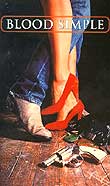 The
first feature film from independents Ethan Coen (producer) and Joel Coen
(director) - the complex, suspenseful Gothic, film noir thriller Blood
Simple (1984) was just the beginning of their many off-beat, dark-edged
films - this one featured the screen debut of Coen regular Frances McDormand. It was a tale of murder, mis-read motives, a premature burial, plot twists, and a gruesomely-impaled
hand (belonging to vile private eye M. Emmet Walsh). The black comedy won the Grand Jury Prize at the newly-created Sundance Film Festival. Raising Arizona (1987) was next - an original, contemporary
screwball comedy-farce about the kidnapping of a baby (one of the Arizona
quintuplets) by a childless couple (Holly Hunter and Nicolas Cage). The
first feature film from independents Ethan Coen (producer) and Joel Coen
(director) - the complex, suspenseful Gothic, film noir thriller Blood
Simple (1984) was just the beginning of their many off-beat, dark-edged
films - this one featured the screen debut of Coen regular Frances McDormand. It was a tale of murder, mis-read motives, a premature burial, plot twists, and a gruesomely-impaled
hand (belonging to vile private eye M. Emmet Walsh). The black comedy won the Grand Jury Prize at the newly-created Sundance Film Festival. Raising Arizona (1987) was next - an original, contemporary
screwball comedy-farce about the kidnapping of a baby (one of the Arizona
quintuplets) by a childless couple (Holly Hunter and Nicolas Cage).
Through his independent Zoetrope Studios, Francis Ford Coppola financed
the exorbitantly-expensive and experimental One From the Heart (1982),
a romantic musical set in Las Vegas. The stylized film was innovatively
shot entirely on videotape within the controlled environment of the studio.
And writer/director Michael Moore's iconoclastic documentary Roger
& Me (1989), an expose about the disastrous effects of the closing
of a General Motors plant (headed by CEO Roger Smith) on Flint, Michigan,
earned almost $8 million - the highest ever earned for its genre.
Independent Film-Maker Steven Soderbergh:
 Versatile independent film-maker/writer-director Steven Soderbergh's
low-budget, minimalist, character-driven debut film was sex,
lies and videotape (1989).
The film featured four Baton Rouge, Louisiana characters without
obvious sexual activity or nudity: a childless married couple (Peter
Gallagher and Andie MacDowell in her first major screen appearance),
the wife's adulterous sister (Laura San Giacomo), and a high-school
friend (James Spader) of the husband who 'voyeuristically' videotaped
the women talking about their sex lives.
Versatile independent film-maker/writer-director Steven Soderbergh's
low-budget, minimalist, character-driven debut film was sex,
lies and videotape (1989).
The film featured four Baton Rouge, Louisiana characters without
obvious sexual activity or nudity: a childless married couple (Peter
Gallagher and Andie MacDowell in her first major screen appearance),
the wife's adulterous sister (Laura San Giacomo), and a high-school
friend (James Spader) of the husband who 'voyeuristically' videotaped
the women talking about their sex lives.
Its
premiere at Robert Redford's 1989 Sundance Film Festival captured everyone's
attention and helped to encourage the production of other thought-provoking
indies. It was the winner of the top prize (Palme d'Or) at the Cannes Film
Festival, and went on to be a commercial and critical success. [Although
Soderbergh would continue making various films in the next decade, his breakthrough
came in 2000 with two more mainstream films: Erin Brockovich (2000) and Traffic (2000).]
Spike Lee and John Singleton:
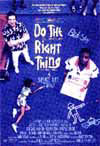 Black
movie-making emerged in a stronger state in the mid-80s, with films from
independent film writer-director-star Spike Lee: Black
movie-making emerged in a stronger state in the mid-80s, with films from
independent film writer-director-star Spike Lee:
- his modest debut was with the hip romantic comedy She's
Gotta Have It (1986), about a liberated, sexually-voracious Brooklyn
woman named Nola Darling (Tracy Camilla Johns) and her three boyfriends;
the film was reportedly made in about two weeks with over-drawn credit
cards budgeted at about $175,000
- School Daze (1988) told about factions in an
African-American Southern college
- Do the Right Thing (1989) - a thought-provoking,
controversial, crackling, prefiguring study of racism in America that
was seen in the explosive conflict and relations between Italian- and
African-Americans, Koreans and white law-enforcement in a Bedford-Stuyvesant
neighborhood block during a stifling hot summer day. (The film was bolstered
with Public Enemy songs on the soundtrack)
- Jungle Fever (1991) - a film that examined inter-racial
romance, starring Wesley Snipes and Annabella Sciorra
24 year-old John Singleton would
soon join Spike Lee as an influential black moviemaker in the early 90s
with his debut film - the coming-of-age drama Boyz 'N the Hood (1991),
one of the highest-grossing films ($57 million) ever directed by an African-American.
With his film, Singleton became the youngest nominee for Best Director
in Academy history, and the first African-American to be nominated
as Best Director.
John Sayles:
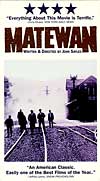 Writer/director/actor
John Sayles first won acclaim for the low-budget Return of the Secaucus
7 (1980) about a weekend reunion of college friends (a precursor of
The Big Chill (1983)) and then directed the independent The
Brother From Another Planet (1984), an E.T-like urban fable about
a black space alien-fugitive pursued in Harlem by white bounty hunters.
His historical drama Matewan (1987) told the true-life story of
exploited 1920s coal miners in Matewan West Virginia, and Passion Fish
(1992) was a more intimate character study of the physical and spiritual
healing of a paralyzed soap opera star in her Louisiana bayou hometown. Writer/director/actor
John Sayles first won acclaim for the low-budget Return of the Secaucus
7 (1980) about a weekend reunion of college friends (a precursor of
The Big Chill (1983)) and then directed the independent The
Brother From Another Planet (1984), an E.T-like urban fable about
a black space alien-fugitive pursued in Harlem by white bounty hunters.
His historical drama Matewan (1987) told the true-life story of
exploited 1920s coal miners in Matewan West Virginia, and Passion Fish
(1992) was a more intimate character study of the physical and spiritual
healing of a paralyzed soap opera star in her Louisiana bayou hometown.
Female Producers/Directors:
One notable milestone in the 1980s and early 1990s was that women producers
and directors were beginning to emerge within the male-dominated film
industry:
- Jodie Foster - Little Man Tate (1991) (actor/director)
- Penny Marshall - Jumpin' Jack Flash (1986) (debut
film as director), Big (1988) (director), Awakenings (1990)
(director/producer)
- Barbra Streisand - The Main Event (1979) (actor/producer),
Yentl (1983) (actor/producer/director/screenwriter), Nuts
(1987) (actor/producer), The Prince of Tides (1991) (actor/producer/director)
- Amy Heckerling - Fast Times at Ridgemont High (1982)
(director), Johnny Dangerously (1984) (director), National
Lampoon's European Vacation (1985) (director), Look Who's Talking
(1989) (director/screenwriter), Look Who's Talking Too (1990)
(director/screenwriter), Look Who's Talking Now (1993) (co-producer)
- Jane Campion - Sweetie (1989) (director/screenwriter),
An Angel At My Table (1990) (director), The Piano (1993)
(director/screenwriter)
- Susan Seidelman - Smithereens (1982) (director/producer/screenwriter), Desperately Seeking Susan (1985) (director), Making Mr. Right (1987) (director/producer), Cookie (1989) (producer/director),
She-Devil (producer/director)
Re-Runs of Previous TV Material:
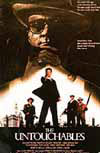 Hollywood studios turned for script material to vintage 50s TV series:
Hollywood studios turned for script material to vintage 50s TV series:
- the serious, popular detective series Dragnet
was converted into the comedy Dragnet (1987) with Dan Aykroyd
impersonating Jack Webb's speech and deadpan manner (e.g., "Just
the facts, Ma'am") as a squarish detective; Tom Hanks starred as
Aykroyd's non-conformist partner Pep Streebeck, and Joe Friday's original
partner in the TV series, Harry Morgan, was featured in a cameo as police
captain Bill Gannon
- a beloved television series was re-worked in Brian
De Palma's Chicago crime film The Untouchables (1987), with a
script from Pulitzer-winning playwright David Mamet, a score from Ennio
Morricone, borrowings from the 'Odessa Steps' sequence in Sergei Eisenstein's
Battleship Potemkin (1925), and Robert De Niro as Al Capone,
Sean Connery as honest Chicago cop Jimmy Malone - an Oscar-winning role,
and Kevin Costner as Prohibition-era federal agent Eliot Ness
Brian De Palma:
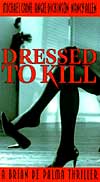 In
the 80s, De Palma was also credited with many sensational, Hitchcock-like
thrillers: In
the 80s, De Palma was also credited with many sensational, Hitchcock-like
thrillers:
- Dressed to Kill (1980) (paralleling Psycho
(1960) and its shower scene)
- Blow Out (1981), a Hitchcockian type film that paid homage to
Antonioni's Blow-Up (1966) and Coppola's
The Conversation (1974)
- the X-rated (then revised to R) Scarface (1983)
with "Godfather" actor Al Pacino as Tony Montana - a violent update of Howard Hawks'
gangster classic Scarface (1932), soaked with blood and cocaine powder in a story of "Scarface's" rise from Cuban emigre-dishwasher to Miami drug lord, along with icy blonde wife Elvira (Michelle Pfeiffer)
- the daring erotic thriller Body Double (1984)
(similar to the voyeuristic Rear Window (1954)
and obsessive Vertigo (1958)) with a
semi-pornographic theme and an infamous drill-murder, featured a memorable,
pseudo 'music video' of "Relax" from one-hit group Frankie
Goes To Hollywood -- set in an S&M porno film!
PG-13 Ratings Debut, and R-Rated, Adult-Oriented Features:
For most of the 70s and part of the early 1980s, the increase in violent
movies, horror films, and slasher films (with an increase in depictions
of violence toward women) encouraged Jack Valenti, the president of the
Motion Pictures Association of America (MPAA) to finally take action.
The MPAA created a new ratings category between R and PG known as PG-13.
It issued its first PG-13 rating (after the inappropriately PG-rated
Poltergeist (1982) and Indiana Jones
and the Temple of Doom (1984) from Spielberg for its heart-ripping sequence) for right-wing writer/director
John Milius' Red Dawn (1984), an imaginative tale reflecting fears
of a Russo-Cuban invasion of the American heartland. By 1986, a rating
of PG was automatically given to films with swearing and narcotics use.
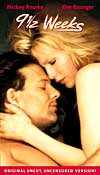 Paul Mazursky's R-rated Down and Out in Beverly Hills (1986),
with Nick Nolte as a homeless person (similar in character to Spielberg's
alien E.T.) befriended by a filthy rich Beverly Hills couple, was noted
for being Disney's (under the name of its adult-oriented subsidiary Touchstone
Films) first film to use the 'F' word. Jack Nicholson was diabolical as Daryl Van Horne in the R-rated black comedy fantasy The
Witches of Eastwick (1987), seductive with Cher, Susan Sarandon, and
Michelle Pfeiffer. The biographical R-rated romantic drama Sid and
Nancy (1986) was a story of punk rock, heroin addiction, infatuation
and doomed love between Sex Pistols' singer Sid Vicious (Gary Oldman)
and groupie Nancy (Chloe Webb). Paul Mazursky's R-rated Down and Out in Beverly Hills (1986),
with Nick Nolte as a homeless person (similar in character to Spielberg's
alien E.T.) befriended by a filthy rich Beverly Hills couple, was noted
for being Disney's (under the name of its adult-oriented subsidiary Touchstone
Films) first film to use the 'F' word. Jack Nicholson was diabolical as Daryl Van Horne in the R-rated black comedy fantasy The
Witches of Eastwick (1987), seductive with Cher, Susan Sarandon, and
Michelle Pfeiffer. The biographical R-rated romantic drama Sid and
Nancy (1986) was a story of punk rock, heroin addiction, infatuation
and doomed love between Sex Pistols' singer Sid Vicious (Gary Oldman)
and groupie Nancy (Chloe Webb).
There
were a few adventurous American films, with R ratings, that were specifically
aimed at adult audiences. As the decade was just about to dawn, Richard
Gere bared all (one of the first instances of a male star appearing nude) as a high-living, convertible-driving gigolo in director
Paul Schrader's American Gigolo (1980), accompanied by Blondie's
song "Call Me." Director Ken Russell's erotic thriller Crimes
of Passion (1984) starred Kathleen Turner as prostitute China Blue
and Anthony Perkins as an obsessive preacher.
 Reflecting
the Puritan morality of the late 80s, however, and inspiring many talk-shows
on its issues of marital infidelity and the dangers of dating, was Adrian
Lyne's follow-up film to Flashdance (1983) - Fatal Attraction
(1987), a suspenseful, melodramatic, erotic thriller about one-night
stands, sexual games, and obsessive love (with Glenn Close as Alex Forrest
- a murderous jilted, stalking woman). Its crowd-pleasing ending was determined
by focus groups and preview audiences and substituted for the original
version found in the script and filmed earlier. Sex was served up very
hot, kinky and steamy in Lyne's next film - 9 1/2 Weeks (1986)
with Wall Street executive Mickey Rourke serving up sensual foods into
art gallery worker Kim Basinger's upturned mouth to the tune of Bryan
Ferry's "Slave to Love." Reflecting
the Puritan morality of the late 80s, however, and inspiring many talk-shows
on its issues of marital infidelity and the dangers of dating, was Adrian
Lyne's follow-up film to Flashdance (1983) - Fatal Attraction
(1987), a suspenseful, melodramatic, erotic thriller about one-night
stands, sexual games, and obsessive love (with Glenn Close as Alex Forrest
- a murderous jilted, stalking woman). Its crowd-pleasing ending was determined
by focus groups and preview audiences and substituted for the original
version found in the script and filmed earlier. Sex was served up very
hot, kinky and steamy in Lyne's next film - 9 1/2 Weeks (1986)
with Wall Street executive Mickey Rourke serving up sensual foods into
art gallery worker Kim Basinger's upturned mouth to the tune of Bryan
Ferry's "Slave to Love."
Revival of Film Noir with Neo-Noir Films:
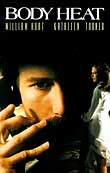 Dark,
shadowy scenes, deadly females, and menacing circumstances were brought
back in modern, revisionistic film noirs in this decade. Lawrence Kasdan's
first film was the steamy, modern-day Floridian, 40's style film noir
Body Heat (1981) (with Kathleen Turner
in a sexy screen debut) - based upon the plot-lines of Double
Indemnity (1944) with William Hurt as the sexually-horny lawyer duped by a rich, gorgeous trophy wife. Jessica
Lange and Jack Nicholson instilled heavy sex in the kitchen into Bob Rafelson's
lackluster remake of the 1946 classic film noir The Postman Always
Rings Twice (1981). Dark,
shadowy scenes, deadly females, and menacing circumstances were brought
back in modern, revisionistic film noirs in this decade. Lawrence Kasdan's
first film was the steamy, modern-day Floridian, 40's style film noir
Body Heat (1981) (with Kathleen Turner
in a sexy screen debut) - based upon the plot-lines of Double
Indemnity (1944) with William Hurt as the sexually-horny lawyer duped by a rich, gorgeous trophy wife. Jessica
Lange and Jack Nicholson instilled heavy sex in the kitchen into Bob Rafelson's
lackluster remake of the 1946 classic film noir The Postman Always
Rings Twice (1981).
Taylor Hackford's Against All Odds (1984) attempted to loosely
remake the classic Out of the Past (1947)
with Rachel Ward as spoiled heroine Jessie (the Jane Greer role), Jeff
Bridges as ex-football star Terry Brogan (the Robert Mitchum role), and
James Woods as gambler/businessman Jake (the Kirk Douglas role). Cast
members from the original film in the remake included Jane Greer (now
as the mother), and Paul Valentine (as a two-bit hood in the original,
but now as Councilman Weinberg). The Coens' Blood Simple (1984)
featured sleazy characters, an endless murder scene, and double-crosses
- all characteristics of classic film noir.
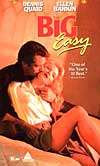 Neil Jordan's Mona Lisa (1986), set in a depraved London, was a
gritty tale about a high-priced call girl (Cathy Tyson) and her ex-con
chauffeur-bodyguard (Bob Hoskins). Alan Parker's occult post-noir Angel
Heart (1987) (originally X-rated) featured a seedy private detective's
(Mickey Rourke) search for a missing singer in New Orleans for a devilish
client Louis Cyphre (Robert De Niro) and involved voodoo, corruption,
devilish circumstances - and an infamous sex scene (restored on unrated
video/DVD releases) between Rourke and The Cosby Show star Lisa
Bonet.
Neil Jordan's Mona Lisa (1986), set in a depraved London, was a
gritty tale about a high-priced call girl (Cathy Tyson) and her ex-con
chauffeur-bodyguard (Bob Hoskins). Alan Parker's occult post-noir Angel
Heart (1987) (originally X-rated) featured a seedy private detective's
(Mickey Rourke) search for a missing singer in New Orleans for a devilish
client Louis Cyphre (Robert De Niro) and involved voodoo, corruption,
devilish circumstances - and an infamous sex scene (restored on unrated
video/DVD releases) between Rourke and The Cosby Show star Lisa
Bonet.
Writer/director David Mamet's moody House of Games (1987) dealt
with the surreal world of con artists and their victims. The first film
appearance of serial killer Hannibal Lecter (later appearing in The Silence of the Lambs (1991) and Ridley Scott's Hannibal (2001))
was in Michael Mann's thriller Manhunter (1986). Jim McBride's
erotic crime noir The Big Easy (1987) featured Cajun music and
a slick detective's (Dennis Quaid) murder investigation and romance with
a repressed DA (Ellen Barkin). Ridley Scott directed the visually-compelling
top-notch romantic crime thriller Someone to Watch Over Me (1987),
while Roger Donaldson's No Way Out (1987) was based on John Farrow's
classic The Big Clock (1948). Al Pacino played a New York police
detective who fell for one of his suspects (Ellen Barkin) - a potential
serial killer in the tense Sea of Love (1989).
 Film History of the 1980s
Film History of the 1980s
Part 1, Part 2, Part 3, Part 4, Part 5, Part 6

 
|
